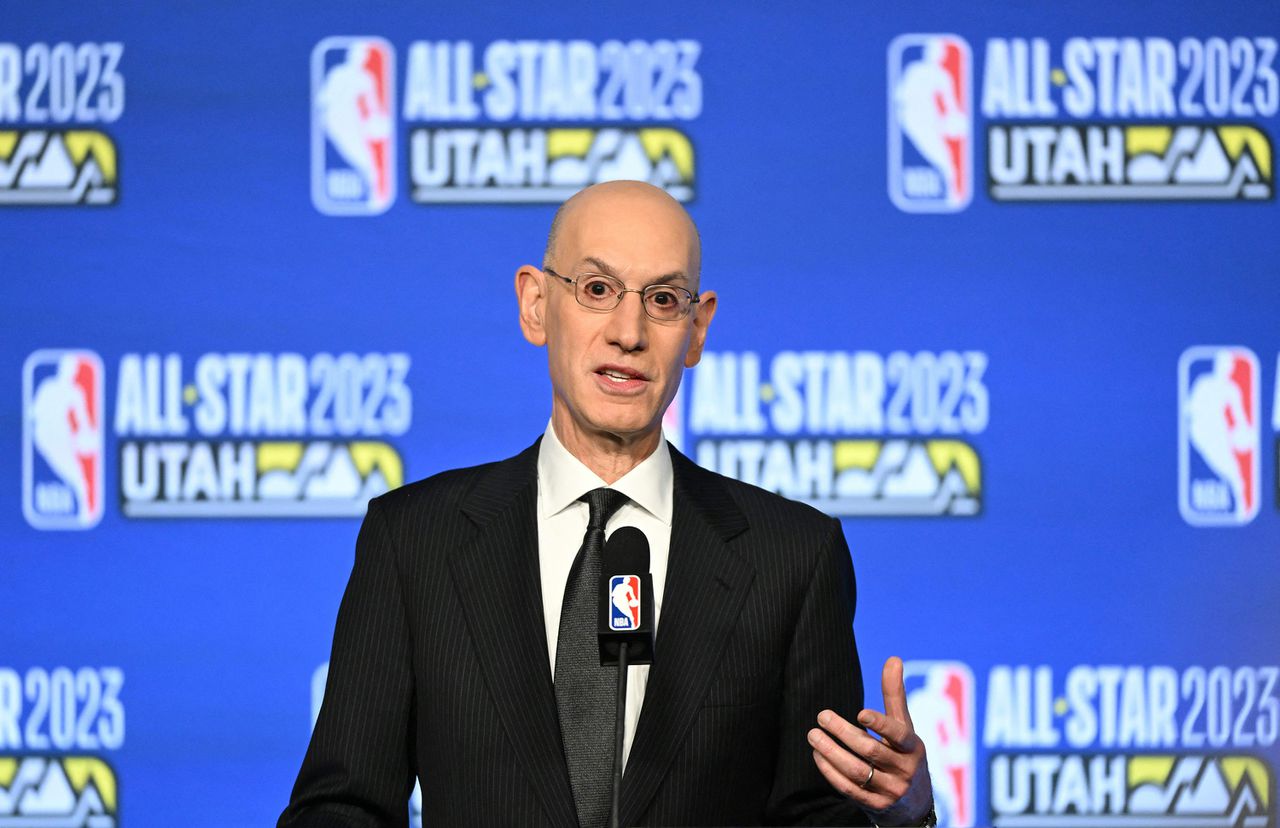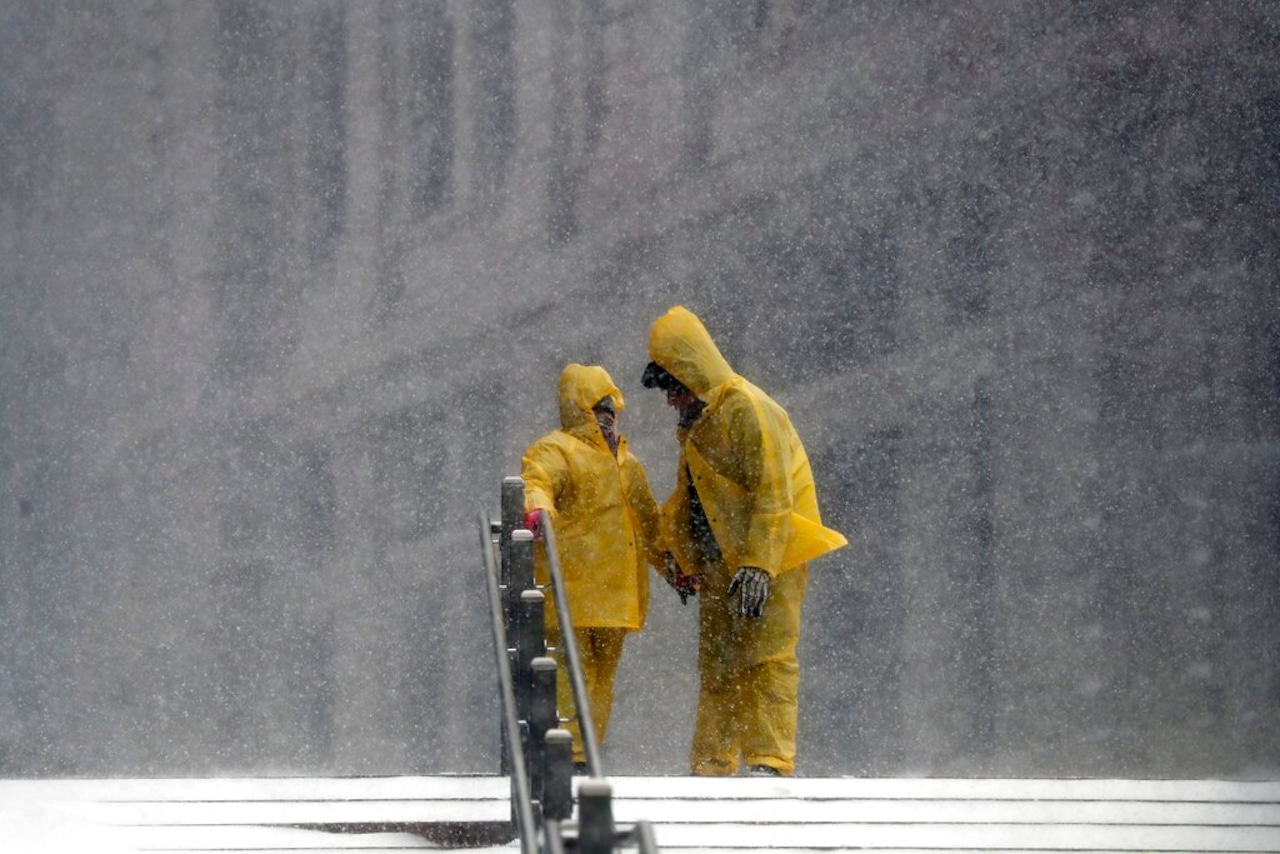Editor’s note: This article was written by Tom Friend and first appeared in Sports Business Journal, the industry’s leading source of sports business news, events and data.

NBA Commissioner Adam Silver speaks during a press conference in Salt Lake City, Utah, on Saturday, Feb. 18, 2023. (Patrick T. Fallon/AFP/Getty Images/TNS) TNSTNS
To the cynics who say the NBA isn’t relevant until Christmas, Adam Silver has a trophy from Tiffany to show you.
An idea that was hatched 15 years ago, that used to put a hop in David Stern’s step, that was inspired in part by Euro leagues, that was vetted by business strategists and data scientists, that turned Zoom meetings into crack-up sessions, that took an unlimited budget and perhaps exceeded it … is now the NBA’s latest pride and joy: the inaugural In-Season Tournament.
Slated for every Tuesday and Friday in November — minus election night — and wrapping up two weeks after Thanksgiving with a Final Four in Vegas, the IST (as it’s commonly known in league circles) is the rarity in U.S. pro sports, a mini-season within a season that involves all 30 teams and customizes playing courts, ball trucks, drip and local/national broadcasts.
“No level of detail is unturned,” said Christopher Arena, the NBA’s head of on-court and brand partnerships.
Best case, IST becomes a jewel in the league’s media rights negotiations or its cinematic TV promotion wins a Sports Emmy or its championship team sips champagne out of Tiffany’s black, diamond-tinged NBA Cup trophy. Worst case: People don’t get the memo.
“Well, we started the education awareness right at Summer League,” said Tammy Henault, the NBA’s chief marketing officer.
Summer League in Las Vegas was actually the NBA’s first public rollout of IST, with Commissioner Silver smiling ear-to-ear during a half-hour pairing show on ESPN that explained nuances of the event. Teams would be broken up into six groups of five. Group winners would advance to a knockout round. A final four would advance to Sin City. All games except the championship would count toward regular-season records. But belied by Silver’s impish grin that day was the fact the NBA had been sweating out those details for over a decade.
As far back as 2008, the IST was a twinkle in the late Commissioner Stern’s eye, who turned the idea over to Silver … who then made it his personal mission. Those who have worked closely with Silver, such as Arena, say the commissioner was the lead voice from the start and made his ops and creative teams feel “uncomfortable” from Day 1. “Uncomfortable in that he was challenging you to push yourself to your limits,” Arena said. “I think this is important to Adam, but I’ll tell you this: It’s important to all of us. We all understand his vision.”
In its infancy stages, IST was never modeled solely after European soccer, and Silver has been known to bristle at the notion he copied UEFA Champions League. Fact is, the league watched college basketball’s holiday tournaments such as the Maui Classic or its conference tournaments and realized auxiliary events carry weight. For over a decade, in internal skull sessions, the league commonly discussed “the future of basketball” and five years ago began vetting two possibilities for its 75th anniversary season of 2021-22: a postseason play-in tournament and an IST.
- Want to receive a nightly roundup of sports business news to your inbox? Sign up for Sports Business Journal’s Unpacks Lite newsletter below.
There was high-level analysis of both within league walls, though the pandemic unexpectedly expedited matters. Forced to create the Florida bubble in 2020, it became necessary to trial the play-in tournament two years early — an unmitigated success. Silver then essentially turned the IST idea over to Evan Wasch, executive vice president of basketball strategy and analytics, who led multi-tiered brainstorms with his staff of strategists/data scientists and took his findings to the league’s board of governors.
Those brainstorm sessions were sitcoms all by themselves. On the serious side, Wasch and his team had to weigh the following questions: Should the IST be separate from the regular season? Should they stage it in November/December or January/February? Should the winner earn an automatic playoff berth or bonus wins or improved playoff seeding or nothing at all? Those meetings, either on Zoom or over lunch, were free-for-alls.
Soliciting proposals from practically anyone, Wasch said advisers amusingly floated a draft-pick prize for the winning team or extra salary cap exceptions or each victory counting as two in the win column or extra days off for the championship squad — comical ad-libbing that had the staff belly-laughing. “Some a little more radical than others, like getting four bonus wins for winning it all, meaning your record is, say, 56-30 instead of 52-30,” Wasch said. “That sort of felt gimmicky. So we evaluated them all, and ultimately, bet on ourselves to build something where we wouldn’t have to create some of those more arbitrary awards.”
In the end, IST was greenlit by the board of governors and NBPA due to fortuitous timing and wise business acumen. From a game-play perspective, they decided a separate IST would be too taxing on the players; that it had to be part of the greater 82-game schedule. They decided if they held it around Christmas, it was too close to the All-Star break and/or playoff races. They decided, with the media rights deal expiring after the 2024-25 season, that they were creating — as Wasch puts it — a new desirable “tentpole” event comparable to All-Star, Christmas Day, play-in and playoffs. They decided, with the CBA negotiations coming to a head last spring, it was the perfect moment to put it to a vote. Then, when it passed, they decided to market the hell out of it.
The key was getting player and fan buy-in. Asked again by Silver to push the envelope, the league enlisted its in-house creative services group to design unique IST-themed playing courts for every arena. Multiple replicas of the black NBA Cup trophy would be stained onto these IST-only playing floors so players and fans would have no doubt — the millisecond they saw it — this game was different. But Arena, the league’s branding exec, needed all 30 teams to chip in and have their individual City Edition colors stained on the home courts as well.
So, on Aug. 10, Arena led a Zoom call encompassing equipment managers, facility leaders and identity contacts from every franchise. “I said, ‘Listen, sometimes there are people in our lives that push us to limits we never thought we could achieve, and this is gonna be one of those moments,’” Arena said. He explained that within a week each team had to sign off on its court color, court logo and court manufacturer — not to mention a City Edition uniform they’d be wearing for IST home games.
He gave each franchise the names of three basketball floor manufacturing companies: Robbins Sports Surfaces, Connor Sports and Horner Sports Flooring. He told them about paint/stain finishing company Bona and the full-service court paint/stain finishing business Praters Flooring. Any of these companies could help find a court, rent a court, sand a court or refurbish a court.
“Everybody in the chat was like: ‘Let’s go, we can do it!’” Arena said. “I’m getting chills right now talking about it.”
On another side of the league office, CMO Henault was working with the agency Translation on more of an IST movie than promotion. At first, internal discussions centered around a “Road to Las Vegas” campaign, which felt perhaps too normalized. Then the group pivoted to an “Ocean’s 11 meets NBA” theme — a short film called “The Heist,” where players such as Anthony Davis (masquerading as a blackjack player) and Kawhi Leonard (lurking in a beanie cap) would scheme to steal the NBA Cup from Draymond Green (dressed as a security guard) before hearing they’d have to win it instead. Henault’s team exulted at that idea, especially when someone pointed out, “You can’t spell Heist without IST.”
In another corner of the NBA office, the media group was contemplating a March Madness uniformity to it all, considering 44 of the 60 group stage games would air on local broadcasts. The idea, which is still being finalized, was to deliver the same music, score bugs and graphics for all games national or local — like the NCAAs — so fans would instantly know it was IST time.
In still another corner, a group was riffing with Tiffany on the black NBA Cup trophy — “a 1B to the Larry O’Brien’s 1A,” Wasch said — as well as a black crystal ball given to each member of the all-tournament team, weighted between 10 and 20 pounds depending on first team, second or third. Players on the winning squad would get engraved medals instead of rings, while basketballs during the Final Four would be branded with the IST logo. Add in a specially designed playing court for Vegas or even the IST insignias on ball trucks, and it’s clear Silver was paying a lot of gold to make the inaugural event a pristine one.
Asked how much IST cost in total — between “Heist” and the stained courts and diamond-infused trophies and crystal balls — the NBA would not say.
“Cost more than a dollar,” Arena said, leaving it all up to the imagination. “And going to be worth the investment.”

Sports Business Journal




